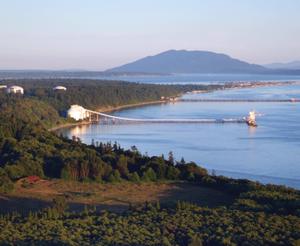
Cherry Point on the Bellingham shoreline with Lummi Island in the background
Islanders encouraged to write letters and ask for hearings to Dept. of Natural Resources
Sustainable Orcas Island (SOI) Irthlingz Environmental Organization, San Juan Conservation District rounded up a roomful of concerned citizens for a forum on Feb. 8 on the impacts of a proposed coal train terminus/shipping port at Cherry Point on the Bellingham shoreline.
The meeting was sponsored by ReSources for Sustainable Communities and the Whatcom County-based activist movement “Power Past Coal.”
Several speakers discussed the ramifications of a permit to allow Peabody Coal, the largest coal company in the world, and SSA Marine, the Cherry Point Port Operator, to build the Gateway Pacific Coal Terminal at Cherry Point which is located in a state-protected aquatic reserve. Coal mined in Montana and Wyoming, would be carried by train up the Puget Sound shoreline, and then shipped to Chinese coal-burning power plants. It is estimated that 48 million tons of coal a year will be shipped to China through the Salish Sea and the Strait of Juan de Fuca.
Dr. Frank James, the Health Officer for San Juan County and for the Nooksack Indian Nation, is also on the organizing committee for Whatcom Docs, a group of local physicians that are working to bring a scientific evaluation of the health impacts of the proposed coal port and coal trains to the region, spoke of the health risks and the likely effects of increased train activity in the state.
He described up to 18 trains a day crossing the state, through populous centers and shoreline to theCherry Point terminal in Whatcom County, each train 1.6 miles long, delivering some 48 million tons of coal annually.
Pollutants that adversely impact health come from the coal dust cargo and diesel fuel particulate matter, containing such toxic elements as mercury, cadmium and lead. While studies indicated that the coal terminal may bring $10 million in tax revenues to Whatcom County, the expense of dealing with particulate pollution have been estimated at $190 million.
James urged opponents of the proposed coal train route and shipping terminal to write letters to Washington State Lands Commissioner Peter Goldmark, who, James said, “has the ability to deny the permit to site the terminal at Cherry Point.”
(Other proposed train routes site their terminals at Longview and Grays Harbor, Washington, and at Mt. St. Helens and Coos Bay, Oregon).
Commissioner of Public Lands Peter Goldmark chairs the state Board of Natural Resources, which sets policy for the management of state trust lands. It also manages approximately 2.6 million acres of aquatic lands, which include shorelines, tidelands, lands under Puget Sound and the coast, and navigable lakes and rivers and natural lakes, generating nearly $35 million per biennium. (from the DNR website)
Matt Krogh, the North Sound Baykeeper at ReSources, said that the organization has “spent years trying to protect Cherry Point.” In 1992, the project was described as a terminal designed for shipping 8 million tons of grain, fertilizer, and other assorted cargoes. Since then, the project has been changed to accommodate 48 million metric tons of coal per year. The terminal project would negatively impact 162 acres of of wetlands.
Plans for the terminal and pier call for it to be sited just south of Cherry Point, the spawning ground for the unique Cherry Point herring, which spawn nearly two months after most Washington herring species. These herring are the primary food supply of salmon, which are then consumed by orcas, humpbacks. Disruption of the food chain there would be “the nail in the coffin for these guys,” Krogh said.
Krogh also listed the impact of super-sized bulk carriers which are not guided by pilot tugs, which come into port “empty” with 17 million gallons of ballast water that is “laden with invasive species such as Asian tunicates, Japanese eelgrass and Chinese mitten crabs.
Fred Felleman, expert on killer whale feeding ecology and environmental consultant to conservation organizations and local and tribal governments, addressed the impacts associated with oil spills. (Felleman is also involved with developing port infrastructure such as the cruise ship terminals at the Port of Seattle and developments at Cherry Point.)
He spoke of the impacts of a coal terminal at Cherry Point during the terminal construction phase, terminal operations and vessel operations, which he said had the most relevance to the San Juan county islands.
Diagrams of the bulk carriers to be used showed ships that dwarf the recent generation of supertankers; they can store 18,000 twenty-foot containers on one ship and are too big to go through the Panama Canal until its expansion is completed. In addition, many of the ships’ operations are automated, with minimal crew levels of a dozen or so personnel, one engine and poor maintenance records. Because the coal cargo is not contained, it creates more wear and tear on the ships as they travel through rough seas.
The bulk carriers are under no requirements to have tug or pilot boat escorts. A spill of the bunker fuel operating these ships is worse than a crude oil spill such as the 1989 Exxon Valdez spill in Prince William Sound, Alaska. It is expected that these ships will use Haro Strait (on the west side of San Juan Island), because Rosario Strait, to the east of the San Juans, is regulated by one-way traffic that requires ships to “wait their turn.” The whales in Haro Strait tend to “clump together, Felleman said: “You could take them all out with one good spill.”
While the Cherry Point coal shipping terminal has been in process for 20 years already, it was pointed out that the coal’s end user — China — has an abundance of coal, but not the infrastructure to make use of it.However, rail and road construction in China is expected to be underway soon, and completely operational by 2015-16, making U.S. production and shipping of coal irrelevant.
It is expected that the Cherry Point terminal permit will be filed mid-March.
Following issuance of a permit, the scoping process dictates what a contractor must consider and address in the project; it is the only time that comments are taken from the public. Speakers at the “Coal Hard Truth” forums in the San Juans last week encouraged the public to request local scoping hearings in the San Juan Islands. Currently they are scheduled for Bellingham, Seattle and Spokane.
The Orcas audience filling the Eastsound Fire Hall was told, “You are the reason the Cherry Point Terminal is not going to happen.”
As some in the audience brought up questions, others hand wrote personal letters which will be delivered to Public Lands Commissioner Goldmark. His email address is >
Also, correspondence may be mailed to Goldmark at:
Department of Natural Resources
PO Box 47000
1111 Washington Street SE
Olympia, WA 98504-7000
**If you are reading theOrcasonian for free, thank your fellow islanders. If you would like to support theOrcasonian CLICK HERE to set your modestly-priced, voluntary subscription. Otherwise, no worries; we’re happy to share with you.**








Great article! Thanks, Margie. I hope people will write to Commissioner Goldmark re their concerns and request a scoping hearing here on Orcas. Odd, isn’t it, that we criticize the Chinese for constructing coal fired power plants – while making plans to sell them the coal!
Great point, Molly. And, appreciate your reporting on this meeting, Margie.
My daughter, son-in-law, and two young granddaughters live in Bellingham and that is reason enough for me to not want to see their health impacted.
Add to that the real potential for harm to our Salish Sea bio-region, I will stay engaged in this process and encourage others in the San Juans to see this as something bigger than a “property rights” issue.
Whatever any of us as islanders can do, let’s please do what we can via email or phone to let the administrative people responsible know that this..WE WON’T ACCEPT.
We, as islanders, can lament what the companies are proposing and doing, and maybe they will win. Only a collective voice will make a difference. At least, let’s try!
I’ve never been a “group” joiner, but this has WRONG written all over it in a long term catastrophic way!
The whole coal-movement venture is motivated by only one thing…fiscal gain by companies with short term foresights; which has always lead to environmental catastrophe throughout history. It’s always about monetary gain. Do the research…NO FOSSIL FUEL ENERGY COMPANY IN THE WORLD, throughout history, has benefited the environment!..none of them…they alwyas hurt. Although there is hope for those (tidal/wind/solar) who haven’t been beaten down yet, but are still trying to make energy happen of Orcas Island. They’re here, and they’re trying!
To really stop progress, I suppose we’ll all need to stop having babies. I doubt that will be happening anytime soon. So — IF progress is to continue then I assume we want RESPONSIBLE parties involved. If one thoroughly looks at the mention companies involved in the Cherry Point site, one will find them ALL to be of the highest integrity. If one closely follows the path of this project, one will see that every attempt to do this the most ecologically way possible IS happening. The coal is in the ground. China (and other developing countries) need (and deserve) this resource. Today that coal is going through Vancouver, B.C. “Tomorrow”, it could be going through a “modern, state-of-the art” facility that is COMPLETELY funded by the participants. It will provide hundreds if not thousands of permenant high paying jobs and millions of dollars annually into this states economy. Readers, please do DILIGENT homework on this issue. The coal, (and for what is worth) grain, and many other important exports will use one of the last deep water port available anywhere on the West coast. Washington State can have that tax money, or maybe some of you would rather those comodities fund the B.C. schools instead. The Cherry Point Terminal will be an important resouce for this state and it is being planned in a most responsible way. Thank you SSA and Burlington Northern for taking the really high road on this very important investment in the Washington economy.
Mr. Branstetter,I must respectfully disagree that all the companies involved operate with the highest integrity. Last year SSA Marine filled in acres of marsh land (illegal)to make a road to do geotechnical drilling on the proposed site. Upon discovery, they claimed they were operating under a valid permit, obtained years before, but for a totally different project. I doubt very much that a company the size, history and experience of SSA Marine didn’t know what they were doing. Trust is not a word I would ever use to describe them. I urge Whatcom county, the Dept. of Ecology, the Army Corps of Engineers and Lands Commissioner Peter Goldmark to do their due diligence in carefully reviewing all concerns from all over WA State as this project affects many more WA citizens and communities than just Whatcom County.